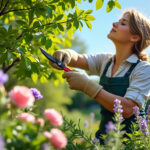Understanding when to prune an apple tree is crucial for promoting healthy growth and maximizing fruit production. This article delves into the best practices for timing, techniques, and care for apple trees post-pruning.
Optimal Timing for Pruning Apple Trees
Pruning an apple tree is not just a seasonal chore; it’s a science. The timing of the pruning is essential for ensuring that the tree maintains its health and productivity. The best time to prune apple trees is during the late winter or early spring months, typically from March to early April. This period corresponds to the tree’s dormancy phase when it is less susceptible to disease and stress.
Understanding Tree Dormancy
During dormancy, apple trees conserve energy, and their physiological processes slow down. This makes it easier for the tree to recover from pruning shocks.
- Less sap bleeding: Pruning during dormancy minimizes sap loss.
- Clear visibility: The absence of leaves provides a better view of the tree’s structure.
- Pest control: Many pests are inactive in colder months, reducing the risk of infestation.
Identifying Local Climatic Conditions
Weather conditions play a significant role in determining the ideal time for pruning. In regions where winters are milder, the pruning schedule may slightly differ. It’s advisable to watch for the last frost date in your area to avoid any late-season cold snaps that could harm the tree post-pruning.
Pruning During Other Times of the Year
While the late winter to early spring window is preferred, light pruning can also occur in the summer months. This technique is often employed to manage vigorous growth and enhance air circulation. However, fall pruning should be avoided as it can lead to new growth that may be destroyed by winter temperatures.
| Season | Pruning Activity | Notes |
|---|---|---|
| Winter | Main structural pruning | Best time to shape the tree. |
| Spring | Minor pruning | Encourage new growth and fruit production. |
| Summer | Greenwood pruning | Manage vigorous growth. |
| Fall | No pruning | Avoid as it encourages tender growth. |
Essential Tools for Pruning Apple Trees
The right tools can make a world of difference in achieving clean cuts and ensuring the health of the tree. An investment in quality equipment is a worthwhile step for any gardener.
Choosing the Right Tools
Different branches require different tools for effective pruning:
- Hand Pruners: Ideal for branches up to 1 inch in diameter.
- Loppers: Suitable for cuts in the 1 to 3-inch diameter range.
- Pruning Saw: Necessary for larger branches exceeding 3 inches.
Maintenance of Tools
Keeping tools clean and well-maintained is essential. Wipe down tools before and after use to prevent the spread of disease. Regular sharpening will ensure clean cuts, which minimizes damage to both the tree and the tools themselves.
Safety Considerations While Pruning
Safety should always be a priority. Wearing protective gloves and goggles can help prevent injury from cuts and flying debris. If using a ladder or working on taller trees, ensure that the ladder is stable and that someone is available for assistance.
| Tool | Best For | Safety Tip |
|---|---|---|
| Hand Pruners | Small branches | Wear gloves to avoid cuts. |
| Loppers | Medium branches | Be mindful of arm positioning. |
| Pruning Saw | Thicker branches | Use a steady grip while cutting. |
Pruning Techniques for Apple Trees
Once the optimal time and tools are established, understanding the basic techniques of pruning is vital for achieving desired results. This section outlines the most effective techniques, each serving a specific purpose.
Thinning Cuts vs. Heading Cuts
Understanding the difference between thinning and heading cuts can significantly affect the growth patterns of an apple tree:
- Thinning Cuts: These involve removing entire branches, which opens up the canopy for more sunlight and airflow.
- Heading Cuts: This technique encourages branching and bushier growth by cutting back a limb to a bud.
Improving Tree Structure
A well-structured apple tree typically has a sturdy central leader and a good framework of scaffold branches. This structure allows even light distribution and supports fruitful branches.
- Identify water sprouts: Remove any upward-growing shoots that don’t contribute to fruit production.
- Clear crossing branches: Ensuring that branches do not rub against each other will prevent damage and disease.
- Balance the canopy: Maintain a pyramidal shape to enhance stability and light access.
Enhancing Light and Airflow
Proper pruning techniques lead to improved light penetration and air circulation. This is critical for reducing the likelihood of diseases and ensuring optimal fruit quality.
| Technique | Purpose | Effect on Tree |
|---|---|---|
| Thinning | Increase light and air flow | Promotes healthier growth |
| Heading | Encourage bushiness | Supports strong fruiting branches |
| Maintenance Cuts | Remove dead or diseased wood | Prevents disease spread |
When to harvest onions for the best flavor and storage
Caring for Pruned Apple Trees
After pruning, the work does not end. Proper care and management of pruned trees are essential for maximizing their health and yield. This section highlights the necessary steps to follow.
Applying Protective Sealants
After making cuts, particularly on larger branches, applying a sealant can help protect the tree from pathogens and pests.
Watering and Fertilization Needs
A newly pruned apple tree often requires additional attention in terms of hydration and nutrition:
- Regular watering during dry spells ensures the tree stays hydrated.
- Applying a balanced fertilizer, such as Miracle-Gro or Espoma, can boost new growth and fruiting vigor.
Monitoring for Pests and Diseases
Ongoing monitoring for pests and diseases is vital. Inspections should be regular, focusing on signs of infestation or disease symptoms.
| Care Action | Frequency | Recommended Products |
|---|---|---|
| Watering | Every two weeks | Garden hose or irrigation system |
| Fertilizing | Every spring | Dramm, Scotts |
| Pest Monitoring | Monthly | Bonide insecticides |
Frequently Asked Questions
1. What is the best time of year to prune apple trees?
The optimal time to prune apple trees is during late winter to early spring, particularly before new growth begins.
2. How much of the tree can be pruned at once?
It is advisable to prune no more than one-third of the tree’s volume in a single session to prevent shock.
3. Can I prune my apple tree in the fall?
Fall pruning is not recommended as it encourages new growth that can be damaged during winter.
4. What tools are essential for pruning?
Key tools include hand pruners, loppers, and a pruning saw for effective branch management.
5. How do I promote fruit production after pruning?
Ensuring adequate sunlight and air circulation, along with proper feeding, can significantly enhance fruit production.









